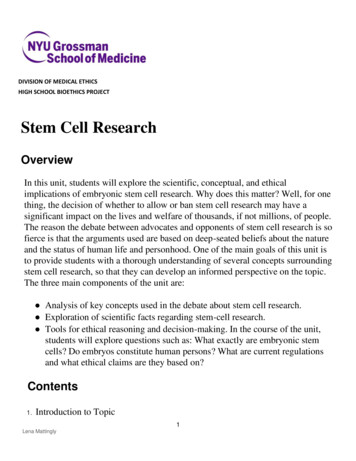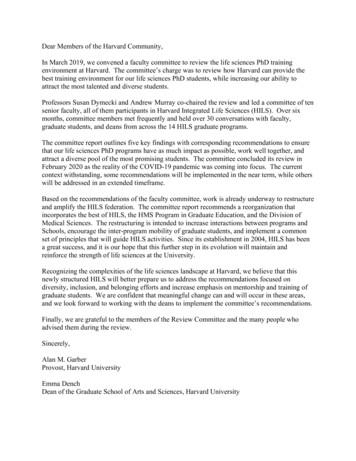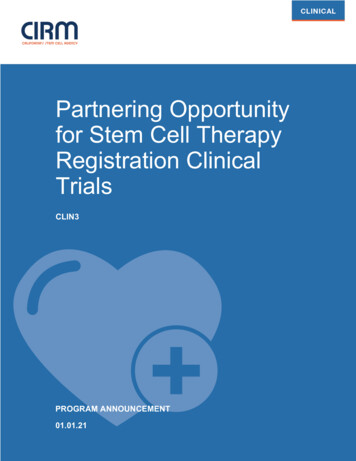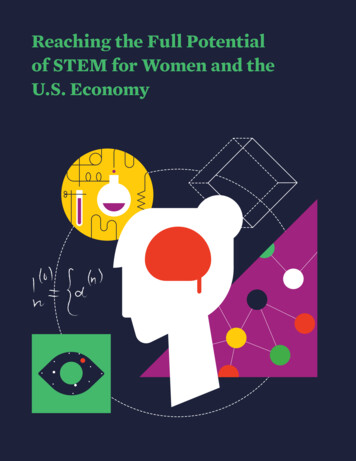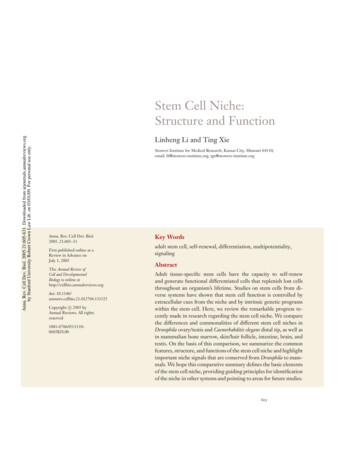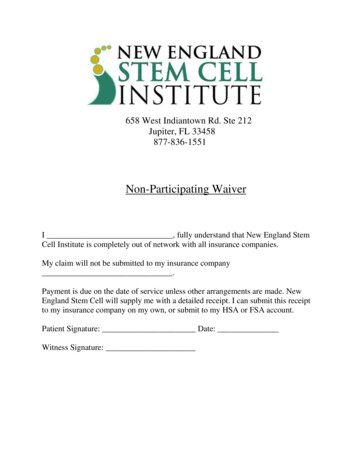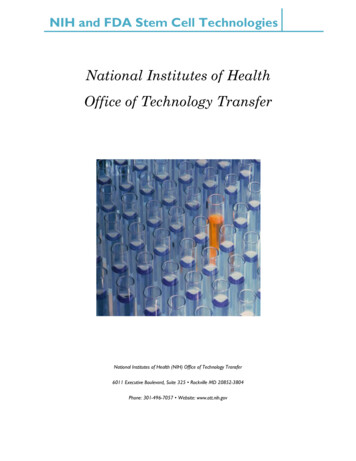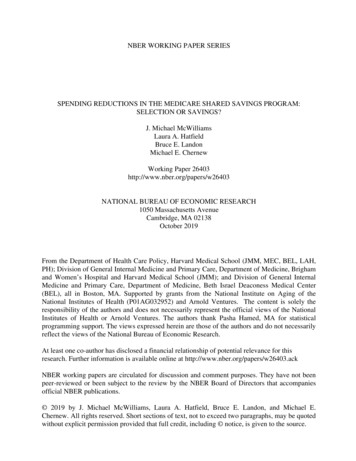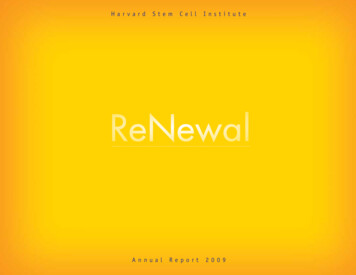
Transcription
HarvardStemAnnualCellReportInstitute2009
C o n t e n t sFrom the Scientific Directors2From the Executive Director3Leading4Collaborating10HSCI Milestones14Supporting16Educating20Selected Scientific Publications24Financials26Leadership27Donor Honor Roll28HSCI at a Glance29
Renewal. What an apt theme for the Harvard Stem Cell Institute’s annual report onthe occasion of our fifth anniversary.After all, renewal — specifically, the capacity for indefinite self-renewal — is oneof the defining properties of stem cells, the remarkable cells from which all of themore than 200 cell types that constitute the human body arise.This has also been a year of renewal, both for stem cell science and HSCI.With the lifting of the federal ban on funding for some types of embryonic stemcell research, coupled with recent scientific breakthroughs that are propelling thefield forward at a faster pace than perhaps anyone imagined a couple of years ago,the entire HSCI community feels a renewed sense of optimism about the promiseand pace of stem cell research. Looking back at what we have accomplished in thefirst five years gives us much hope for what we can achieve in the next five.We also feel a renewed sense of urgency. Patients and families whose lives areprofoundly affected by diseases such as cancer, neurodegenerative diseases,diabetes, cardiovascular disease, and many others, are looking“Everything I know about the work of Harvard Stem Cell Instituteto HSCI and other stem cell scientists to find treatments andmakes me feel that we really do live in historic times — something peoplecures. Not today, but soon.will look back on years from now and see as a watershed in ourunderstanding of human biology and in our capacity to seekAs HSCI enters its next phase — a phase that promises to be astreatments and cures for a myriad of diseases.”— Harvard University President Drew Faust, PhDexhilarating and transformative as its first — it does so with arenewed determination to harness the power of stem cells as tools of discovery andas therapies and, in so doing, to vanquish diseases that are responsible for somuch human suffering.1
From the Scientific DirectorsHAS IT REALLY BEEN FIVE YEARS?On one hand, it’s hard to get our minds around the fact that the Harvard StemCell Institute is now in its sixth year. When we look at what has been accomplished, and when we place that record of accomplishment against those ofprevious sea changes in biology, it’s hard to believe that we haven’t been atthis for decades.On the other hand, has it already been five years? It feels like only yesterdaythat the field of stem cell biology was emerging as something so many people created a new paradigm for stem cell research, in which we use stem cells astools to advance the understanding and treatment of disease, rather than as endsin themselves launched the careers of many younger scientists, from undergraduates to newinstructors created Harvard’s first interdisciplinary, inter-school department, and with it anew undergraduate concentration in Human Developmental and Regenerative BiologyAnd what do we hope all this leads to in the coming period of renewal? Whathad an interest in, yet so few of us were working together on. Was it really fivedo we hope to be able to write in the directors’ letter in the Harvard Stem Cellyears ago when we saw that there was a tremendous need to create new relation-Institute annual report for 2013?ships in order to take advantage of a community that had, in addition to itsBy the end of our first decade we hope to be able to tell you that the break-obvious academic strength, the unique ability to bring therapies to patients?throughs at HSCI, coupled with the growth of our therapeutic screening program,So what has HSCI accomplished thus far, in spite of a virtual ban on federalhave led to the development of new drugs for the treatment of one or morefunding of embryonic stem cell research? With the exception of Kyoto University’sdiseases. We hope to be able to tell you that our research has made possibleShinya Yamanaka’s initial breakthrough development of induced pluripotent stemimprovements in cell replacement therapy for blood diseases and diabetes. We(iPS) cells, many of the critical advances in the field have been achieved underhope to be able to tell you that we have an improved understanding ofthe HSCI umbrella.Parkinson’s disease, ALS, and a number of other diseases.As you will read in the following pages, HSCI researchers have, among otherMost important, we know that five years from now we will be able to tell youaccomplishments:that the HSCI experiment allowed us to re-imagine how science is done, shifting created a unique scientific community in which collaboration is a given, ratherthan an exceptionfrom a single-investigator, independent laboratory-based paradigm to one in created the majority of the embryonic stem cell lines being used today byresearchers around the worldthat, we know, will speed results and bring treatments and cures to patients who created more than 20 disease-specific stem cell lines and cell types, allowingscientists to study disease development in laboratory dishes isolated the stem cells that participate in cardiac development successfully reprogrammed one type of fully formed adult pancreatic cell intoanother, without going through the stem cell stage improved the efficiency of blood stem cell transplantationwhich collaborative goals and vision trump individual ego and career focus. Andso desperately need them.Finally, we would be remiss if we did not underscore the fact that our workover these past five years would not have been possible without the extraordinarygenerosity and foresight of so many individuals, foundations, corporations, andfunding agencies. We are grateful for this support—this expression of confidenceand belief in the work of the Harvard Stem Cell Institute—and the platform it hasgiven us to build on over the next five years. initiated a therapeutic screening program that holds the promise of speedingthe development of new treatments for a host of chronic diseasesDavid T. Scadden, MD, and Douglas A. Melton, PhDCo-Directors, Harvard Stem Cell Institute2Douglas A. Melton, PhDDavid T. Scadden, MD
From the Executive DirectorCONSIDERING HOW MUCH HAS BEEN ACCOMPLISHED — BOTH ON THEwill foster and renew fruitful collaborations. Although the construction of theorganizational front and, as the Scientific Directors’ letter describes, on the scien-Allston Science Complex had to be put on hold because of challenging economictific front — it is difficult to believe that it was just five years ago that Harvardconditions, the University has an unwavering commitment to stem cell biologyStem Cell Institute was established. Few start-up organizations, especially ones ofresearch and education. So, beginning this fall, two contiguous buildings in thesuch size and complexity and with such a bold agenda, can claim so muchheart of the Cambridge campus will undergo a major renovation. When this workprogress in such a short period of time.is completed in 2011, these will be the new home of the administrative officesDuring our first five years — a period we refer to as phase one — we wereable to provide proof of concept for HSCI. We showed that this unique collaboration involving all of Harvard’s schools and more than 900 scientists across 11and core faculty of HSCI and Harvard’s closely aligned Department of Stem Celland Regenerative Biology.In the coming years, HSCI will surely benefit from the availability of federalHarvard-affiliated hospitals and research institutions works — and works well. Wefunding for some types of human embryonic stem cell research made possible bydemonstrated that we can achieve important scientific results that attract signifi-the recent easing of the Bush administration’s restrictions. While we certainlycant support from private donors, foundations, and the commercial sector, whichwelcome this change, it does not alter the fact that HSCI will continue to relyis essential to rapidly moving these results from laboratory benches to patients’heavily on philanthropy and commercial-sector alliances to continue moving thebedsides. In five short years, HSCI has become the acknowledged internationalfield rapidly forward.leader in stem cell research.As we enter our next five-year period — phase two — we are doing so with aOne reason is that, regrettably, not all types of embryonic stem cell researchare eligible for federal funding. Another is that the focus and ongoing fundingrenewed sense of confidence in, and excitement about, what we can accomplish.levels of the National Institutes of Health have not changed, at the same timeWe will continue to invest in our seed grants and support our junior facultythat the competition for research dollars is especially fierce. Meanwhile, HSCI’scollaborations, which have been a resounding success in terms of early careerfunding from disease foundations, whose endowments have suffered during thedevelopment and scientific breakthroughs. We will continue to push collaborativeeconomic downturn, has also decreased.brainstorming and decision-making in our program think tanks, which are key toIn this, our fourth, annual report we are proud to share with you many of theidentifying our research priorities and staying on course. And we will continue tohighlights of an incredibly exciting year. As we embark on a new year and ourre-invest in and expand our core facilities, particularly our Therapeutic Screeningnext new phase, we urge you to support us with a renewed sense of hope for theCenter and the iPS Core, which are unique in the field.enormous promise of stem cell research.Phase two is also when we will cease to be an exclusively virtual communityand many faculty members will come together in a single location — a move thatBrock C. Reeve, MPhil, MBAExecutive Director, Harvard Stem Cell Institute3
LEADINGBY ANY AND ALL MEASURES, IN JUST FIVE YEARS OF ITSexistence, Harvard Stem Cell Institute has become the international leader in stem cell research. During this short time span,HSCI has: created a new paradigm for how biomedical research can beconducted — through collaboration and a shared commitment tofinding treatments and cures for many intractable diseases thatafflict millions created and distributed more human embryonic stem cell linesthan any other institution, supplying more than 200 researchprograms worldwide achieved some of the most significant scientific breakthroughsin stem cell research established core facilities that are unique in an academic setting and are expediting the pace of bringing discoveries frombench to bedside supported the early careers of innovative young scientistswho have already gone on to make significant contributions tothe fieldWith 190 faculty members and 900-plus scientists workingcollaboratively across 11 world-class hospitals and research institutions in diverse but interrelated areas, from diabetes and cancer to stem cell aging, HSCI has been, and will continue to be,the leader in stem cell science.With the knowledge gained in just the past five years ofHSCI’s existence, scientists now realize that stem cells haveenormous potential not only for cell-based therapies, or regenerative medicine, but also as powerful tools to study diseases asthey develop — which could reveal new targets for therapy —and to search for therapeutic agents that are both safe andeffective.4 PATIENT-DRIVEN RESEARCHConsistent with its focus on ultimately “taking out” many prevalent diseases, HSCI research is organized into disease programs.Each program crosses the boundaries of institutions, departments, and laboratories, resulting in the cross-fertilization ofideas and sharing of resources that hasten the pace of discoveries and their translation to the clinic.During its next phase, as HSCI continues to mature andexpand, it is likely that new disease programs will emerge.Because many areas of stem cell science pertain to multiplediseases, HSCI also has several Scientific Programs that span ourdisease programs, as well as a Translational Research Program,which has the specialized expertise to help move HSCI’s discoveries from bench to bedside quickly and efficiently.HSCI Disease Programs Blood DiseasesCancerCardiovascular DiseaseDiabetesKidney DiseaseNervous System DiseasesOther HSCI Scientific Programs Junior Faculty ProgramCell DevelopmentEpigenetics of Stem CellFunction and AgingStem Cell Regulation Translational Research400 Scientific PublicationsOne metric by which scientific progress is measured ispublication in peer-reviewed scientific journals, whereadvances in stem cell research are shared with scientistsworldwide. By this measure alone, HSCI is the unequivocal leader. In fact, HSCI has published more papers inhigh-impact journals than any other stem cell group,anywhere.Between June 2008 and June 2009, for instance, morethan 400 papers on a wide range of topics relating tostem cell research — on average, more than 33 a month— were authored by HSCI principal faculty members andpublished in influential journals such as Nature, CellStem Cell, Science, and others. This compares to “only”280 papers published by HSCI principal faculty over thesame period just two years ago.
2008-2009 RESEARCH BREAKTHROUGHSThe past year, in particular, has been impressive in termsof the strides made in stem cell research — many of whichtook place at HSCI. Indeed, in some areas — particularly theexploding field of cell reprogramming — the word “leaps” ismore accurate, as these advances have fast-forwarded scientists’ ability to turn back the cellular clock to learn what goesawry to cause a disease and to screen disease-specific cells forpotential therapeutics.Following, in chronological order, are brief summariesof some notable HSCI research breakthroughs during 20082009; details about these and other major findings areavailable on the HSCI website (www.hsci.harvard.edu).ALS in a dishFrom the skin cells of patients suffering from a specificdisease — amyotrophic lateral sclerosis (Lou Gehrig’s disease)— HSCI researchers use the new induced pluripotent stem(iPS) cell technology to produce motor neurons, the very celltype destroyed in this disease. By creating this “disease in adish,” scientists are now able to study what causes this fatalneurodegenerative disease. This technology can also be usedto create other disease-specific cell lines with which toobserve how a disease develops, identify targets for therapy,and screen for compounds that are both safe and effective.Kevin Eggan, PhD, and colleaguesMultiple disease-specific stem cell linesUsing the iPS cell technology, HSCI scientists produce 20disease-specific human stem cell lines for diseases includingParkinson’s disease, type I diabetes, Huntington’s disease,Down syndrome, two forms of muscular dystrophy, and others,and make these available through HSCI’s new iPS Core Facilityto researchers worldwide. George Daley, MD, PhD, andcolleaguesHigh-Impact ScienceHSCI recently conductedits annual survey asking principalinvestigators whose projects ithas funded about the impact thissupport had on various aspects oftheir work. Some of this year’sresults:41%were able to attract additional,external funding85%reported new findings60%reported publications in leadingjournals10%created new intellectualpropertyDirect reprogrammingFor the first time, HSCI researchers convert one type of adultcell (a pancreatic exocrine cell) directly into another type of5
LEADINGadult cell (an insulin-producing beta cell, which is missing inindividuals with Type 1 diabetes), in mice. This is a simpler, moredirect approach than the multi-step process required to turn anadult cell to an embryonic-like state (the iPS, or induced pluripotent stem cell, technology) and then direct it to become anothertype of adult cell. Douglas Melton, PhD, Qiao Zhou, PhD, andcolleaguesMaking iPS cells saferTwo groups of HSCI researchers find new, safer ways to produceinduced pluripotent stem (iPS) cells, bringing them one stepcloser to the clinic. Production of these embryonic-like cells fromadult cells formerly required the use of four genes, two of themcancer-causing, inserted into the cells’ genome using retroviruses,which also have the potential to cause tumor growth. One group(Konrad Hochedlinger, PhD, Gordon Weir, MD, and colleagues) discovered that it is possible to create mouse iPS cells using adenoviruses, which do not incorporate into cells’ DNA, to ferry thegenes. Using a different approach, the second group (DouglasMelton, PhD, Danwei Huangfu, PhD, and colleagues) used a chemical known to be safe in humans to eliminate the need for two ofthe four genes — the cancer-causing genes. Work is underway todetermine if chemicals and other approaches could be used toreplace all four genes.HSCI: The AcknowledgedLeader WorldwideHSCI comprises the greatest concentration of stem cellscientists in the world, and is the acknowledged leaderin stem cell research nationally and internationally. Anindependent study of 3,300 institutions worldwideconducted two years ago showed that HSCI was numberone in 11 out of 14 areas of stem cell research.6Using stem cells to improve muscle functionin mice with muscular dystrophyBy transplanting muscle stem cells from healthy mice into micewith the most common form of muscular dystrophy (MD), HSCIresearchers demonstrate for the first time that these cells couldimprove muscle function in the diseased mice, and also provide areservoir of additional healthy stem cells that could be reactivatedfor future muscle repair. This breakthrough provides proof of concept that stem cell transplantation can treat a muscle degenerative disease such as MD. Amy Wagers, PhD, and colleaguesIdentification of the mechanism that directs bloodstem cells to their destinationHSCI researchers identify in mice the cellular mechanism thatdirects blood stem cells to their ultimate destination in the body.This finding could benefit patients undergoing bone marrowtransplantation (a form of stem cell therapy), as well as othertherapies using stem cells, which to be clinically useful mustefficiently home in on their target. The group also reportsalready-approved drugs that stimulate this pathway and improvecells’ homing ability. David Scadden, MD, and colleaguesA drug that increases blood stem cells inumbilical cord blood is evaluated in patientsUmbilical cord blood is a readily available source of hematopoietic(blood-producing) stem cells (HSCs) for patients who may nothave another source. However, cord blood has too few HSCs foruse in many adults. A drug identified by HSCI researchers thatincreases HSCs in cord blood is now being evaluated in cancerpatients in a phase 1 clinical trial. If this and subsequent trialsshow that the drug, which was identified from studies usingzebrafish, is safe and effective, many cancer patients couldbenefit. Leonard Zon, MD, Trista North, PhD, WolframGoessling, MD, PhD, and colleaguesFrom human embryonic stem cells, discovery of amaster heart cell from which the three major tissuetypes of the heart developFrom human embryonic stem cells, HSCI researchers are the firstto identify and isolate the earliest master human heart cell fromwhich all three of the major cell types of the heart arise. Thisbreakthrough, which builds on the 2007 HSCI discovery of a masterheart cell in mice, has major implications for understanding andperhaps eventually preventing or treating congenital heart disease (CHD) and adult-onset heart disease, such as heart failureand heart attack, the leading cause of death in developednations. Especially exciting is the group’s discovery that someforms of CHD arise from these master cells — a finding thatsuggests new targets for therapeutic intervention for the leadingbirth defect in children worldwide. Kenneth Chien, MD, PhD,and colleagues
A beating heart and flowing blood are neededfor the development of blood stem cellsIn studies of zebrafish, mice, and mouse embryonic stem cells,two groups of HSCI researchers found that the biomechanicalstresses created by a beating heart and flowing blood are necessary for the development of the blood system. In multiple experiments, they also showed that nitric oxide, which increases in thepresence of flowing blood, is a key regulator of the process ofblood stem cell production across vertebrate species. Understanding how the blood system develops may suggest new therapeutic strategies for patients with diseases of the blood, such asleukemia, immune deficiency, and sickle cell anemia. LeonardZon, MD, Trista North, PhD, Wolfram Goessling, MD, PhD, GeorgeDaley, MD, PhD, and colleagues TWO CORE FACILITIES HASTEN THE PACE OF RESEARCHEver mindful of its mission to accelerate the pace of stem cellresearch, HSCI has made significant investments in core facilitiesthat are shared by the entire HSCI research community. HSCI’scores not only provide highly specialized expertise and costlytechnologies that no single laboratory or institution could affordon its own, but also serve as important hubs for scientificinteraction and collaboration.While all the cores are vital to stem cell research, two — theTherapeutic Screening Center, established in late 2006, and theiPS Core Facility, which was launched last summer — set HSCIapart from other stem cell research enterprises worldwide. Theirunique capabilities, which more typically reside in the commercial sector, play a vital role in hastening discoveries arising fromHSCI Core Facilities at a GlanceiPS Core Facility:stores iPS cells produced by HSCI scientists, generatesnew disease-specific iPS cell lines, and distributes iPScell lines to HSCI and the scientific communityTherapeutic Screening Center:provides expertise and technologies to identify factorsthat direct stem cell differentiation and proliferation,and to screen stem cells for understanding of diseasemechanisms and therapeutic agentsGenome Modification Facility:provides expertise and develops genetically modifiedmouse models for HSCI researchersFlow Cytometry Core Facilities:provide high-speed cell sorters, cell analyzers, dataanalysis computers, and other instruments required byscientists across the HSCI community7
LEADINGHSCI’s laboratories into the clinical setting for the benefit ofpatients. Indeed, the Therapeutic Screening Center’s expertise inthe drug-discovery process has attracted significant attentionand support from pharmaceutical companies, disease foundations, and the federal government, alike. Funding sources includeGlaxoSmithKline, Vertex Pharmaceuticals, Eli Lilly, the SMAFoundation, the ALS Association, the National Institutes ofHealth, and the Department of Defense, among others.The Therapeutic Screening Center (TSC) uses state-of-the-arttechnologies, such as high-throughput cell-based screening, tosearch for compounds that might safely treat a given disease, orto identify factors that direct stem cells to differentiate and proliferate in order to create new assays that could, in turn, lead tonew therapies. The TSC serves the entire HSCI research community and works in many disease areas, but has made especiallynoteworthy advances in devastating motor neuron diseases likespinal muscular atrophy and amyotrophic lateral sclerosis. Infact, the TSC has already identified molecules that increase thelevels of SMN, the protein that is defective in patients with SMA,and is now testing these in mice.Just last year HSCI established its iPS Core Facility in orderto tap the full potential of exciting advances in induced pluripo-tent stem (iPS) cell technology, many of which were developedin HSCI laboratories. Overseen by a committee of HSCI’s cellreprogramming experts, the iPS Core serves as a laboratory togenerate disease-specific iPS cell lines, as a repository for HSCIiPS cell lines, and as a distribution center from which to sharethese valuable resources with HSCI scientists and the scientificcommunity. The iPS Core has many strengths — most notably itsability to quickly incorporate advances in reprogramming technology as they are made by scientists, coupled with its closerelationship with the Harvard-affiliated hospitals for access topatients with diseases of interest. Even though the iPS Core isstill in its early stages, it has already distributed many cell linesto researchers in North America, Asia, and Europe. HSCI INNOVATORS EARN HHMI APPOINTMENTSHSCI fosters a culture in which innovation and creativity areencouraged and supported. Within this unique environment,many young scientists have found the ideal milieu in which topursue novel ideas, however risky they might seem.This spring, the prestigious Howard Hughes Medical Institute(HHMI) selected four HSCI faculty members as winners of itsEarly Career Science Competition, citing their demonstratedTherapeutic Screening Center AchievementsIn 2006, HSCI made a major investment in its Therapeutic Screening Center (TSC), betting that this core facility would “pay off” in terms of tangible results in perhaps five years.In fewer than three years, the “bet” has already paid off — in significant scientific achievements across many disease areas, pivotal scientific papers, and additional funding from multiple sources,including the commercial sector. Following are a few of the TSC’s many achievements, all of which involved collaborations with HSCI researchers.Spinal muscular atrophy (SMA) – identified pathways that regulateParkinson’s disease – created dopaminergic neuron progenitors;Diabetes – derived strategy to produce pancreatic progenitors fromthe level of the protein (SMN) that is defective in SMA; identified thecurrently inducing these cells to differentiate into functional dopaminer-human embryonic stem cellsonly class of molecules that increase SMN levels and prolong survivalgic neurons for studying disease mechanisms and for screeningReprogramming – identified molecules that replace the essential cellof motor neurons; tested several small molecules in mice thatHuntington’s disease – created medium spiny neuron (MSN) progeni-reprogramming factorsincrease SMNtor cells; currently inducing these cells to differentiate into functional MSNsNeuropathy – generated pain neurons (nociceptors) from humanAmyotrophic lateral sclerosis – identified several motor neuronthat can be used for studying disease mechanisms and for screeningembryonic stem cells; currently further characterizing these cellssurvival-promoting compounds that are currently being tested;established a screening based on the new understanding of the ALSdisease process that arose from HSCI work8
ability to approach science with creativity and innovation.Among the 50 young scientists nationwide chosen to havetheir work supported by HHMI were HSCI faculty membersBradley Bernstein, MD, PhD, Kevin Eggan, PhD, KonradHochedlinger, PhD, and Amy Wagers, PhD. A fifth Harvardresearcher, Rachel Wilson, PhD, of Harvard Medical School, wasalso selected for the award. All four HSCI faculty are past recipients of HSCI seed grants, which fund innovative, early-stageresearch (see page 16).Each of the new HHMI Early Career Scientists will receive asix-year appointment to HHMI, which includes full salary, benefits, and a total research budget of 1.5 million. HHMI will alsocover other expenses, including research space and the purchaseof critical equipment. HSCI SCIENTIFIC LEADERSHIP WIDELY RECOGNIZEDHSCI’s leadership in stem cell science is widely recognized, fromthe halls of Congress to national media outlets.In 2009, for example, for the second time in three years,HSCI Co-Director Douglas Melton, PhD, was named by Time magazine as one of the 100 most influential people in the world. Thisyear, Melton was nominated by U.S. Senator Orrin Hatch, ofUtah; in 2007, Melton was nominated by actor Michael J. Fox,who has Parkinson’s disease.Last year, Time magazine also cited work done by HSCI faculty member Kevin Eggan, PhD, and his colleagues in creatingthe first motor neurons from patients with amyotrophic lateralsclerosis (Lou Gehrig’s disease) as its top medical breakthroughin 2008.When Time magazine published a February 2009 cover featureon the state of stem cell science, “How the Coming Revolution inStem Cells Could Save Your Life,” it focused largely on theachievements of Melton and other HSCI faculty.9
COLLABORATINGCOLLABORATION IS ESSENTIAL TO MAKING PROGRESS AGAINSTdiseases as complex as cancer, diabetes, cardiovascular disease,and neurological disorders — among the many diseases for whichstem cell research could lead to treatments or cures.But for meaningful collaboration to take place, scientistsmust be given the encouragement, resources, opportunities, andincentives to reach beyond the relative isolation of their laboratories, their institutions, their countries — even their own specialties and disciplines — to learn from, share with, and joinforces with others in academia and industry who are focusing onthe same big challenges. As a critical part of its mission,HSCI fosters collaboration, both internally and externally, inmany ways. THINK TANKSThree years ago, a group of leading neuroscientists from theUnited States and abroad gathered in Cambridge for an intensivetwo-day meeting under the auspices of HSCI’s Nervous SystemDiseases Program. The agenda was to share their current knowledge about Parkinson’s disease, identify gaps in that knowledge,and define the most promising areas of research going forward.Based on the success of this inaugural event, the NervousSystem Diseases Program has hosted a think tank every yearsince. Among the many positive outcomes of these meetings hasbeen the creation of new cross-institutional collaborations andresearch projects.“HSCI has been very instrumental in my science in the way it has fostered interactions and brought scientistswith diverse backgrounds together. It embodie
existence, Harvard Stem Cell Institute has become the interna-tional leader in stem cell research. During this short time span, HSCI has: created a new paradigm for how biomedical research can be conducted — through collaboration and a shared commitment to finding treatments and cures for many intractable diseases that afflict millions
